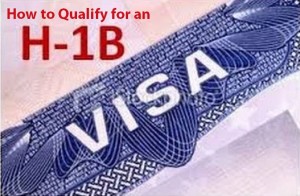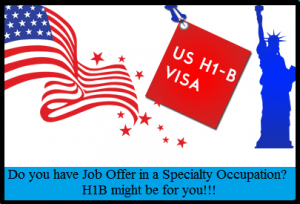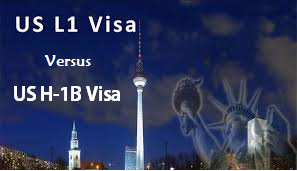 How to Determine Whether You Qualify for an H1B Visa
How to Determine Whether You Qualify for an H1B Visa
Many individuals from around the world look at the United States as the ultimate destination to fulfill their American Dream. It is well-recognized that the United States provides a wide variety of different employment opportunities. The H1B Visa provides foreign nationals with the chance to obtain temporary employment in the United States. As a result, this is one of the most sought after visas for the United States. However, there are eligibility requirements and criteria that foreign nationals must abide by in order to apply for this visa. Therefore, in this article, I will address what an H1B visa is, the eligibility requirements for an H1B visa, how to apply for an H1B visa, and much more.
What is an H1B Visa
An H1B visa is defined as a temporary work permit for foreign nationals that specialize in specialty occupations. In other words, this visa allows employers to hire foreign workers for a short period of time. A specialty occupation is defined as work that includes theoretical and practical application of highly specialized knowledge in one of the following fields of work:
- Accounting
- Architecture
- Arts
- Biotechnology
- Business
- Chemistry
- Education
- Engineering
- Law
- Mathematics
- Medicine & Health
- Physical Sciences
- Social Sciences
- Theology
In order for your specialized occupation to be recognized by a potential employer in the United States, you must have the appropriate educational qualifications. Therefore, in order to be eligible to apply for an H1B visa, you must have completed a minimum of a Bachelor’s Degree in one of the aforementioned fields of study. Additionally, if required, you will also need to provide a state licensure in order to practice in that specific field.
How to Qualify for an H1B Visa
Much like any other immigration application to enter the United States, there are specific criteria and qualifying requirements that applicants must abide by. In order to qualify for an H1B visa, you must:
- Obtain a Bachelor’s Degree or the equivalent
- Apply to work in a specialty occupation, such as any of the fields listed above
- Earn an income that is the wage or the prevailing wage for the intended occupation
- Have a relationship with the sponsoring employer who intends on hiring you
- Intend on working in a specialty job that relates to your field of study
- Obtain an H1B visa number prior to filing the petition, unless it is exempt
- Ensure the employer meets the Department of Labour requirements and must file a I-129 form with the USCIS (U.S. Citizenship and Immigration Services) for permission to hire you
How to Apply for an H1B Visa
In order to apply for an H1B Visa, there are several steps that must be taken prior to actually entering the United States and successfully start working. The first and most important consideration you should note is that you cannot file for an H1B visa for yourself. The prospect employer must file the application for you. Specifically, the first step in applying for an H1B visa entails the employer filing a petition to sponsor you into the United States. Additionally, the USCIS also has requirements that must be met by the prospect employer, such as providing an employment letter. The employment letter must also provide details about the intended position that will be filled by the foreign worker, the job duties of the intended position, the dates of employment, and information about the supervisor and co-workers of the employee.
The next step in the application process of the H1B visa is to determine and compare the actual wage and the prevailing wage. Keep in mind, the prevailing wage is determined by the State of Employment Security Agency by completing a form which asks for details surrounding the responsibilities and experience needed for the intended position. On the other hand, the actual wage is determined by comparing the wages of other employees in the same position with the same amount of experience. Consequently, the employer must pay the employee whichever wage is higher. It is important to note that this process takes approximately two months to determine.
Following, the American employer must file a Labour Certification Application (LCA). This specific application provides the USCIS with information of the sponsoring American employer. Upon the completion of this application, the American employer is essentially confirming the pay of the higher of the two wages for the employee and that the employment of the foreign worker will not affect any other employees. Additionally, this application will also ensure that there are no strikes for the intended position at the work place. The advantage of this application is that is also makes sure that the American employer is offering the same benefits to the foreign worker as the rest of the employees.
The last step of the H1B visa application process is filing the petition with the USCIS. This process may take a few months to process. During the time that the application is being processed, USCIS will provide the American employer with a receipt which includes a 9-digit reference number designated for that particular application and includes H1B visa processing times and general information about both the American employer and the foreign worker. Once this is received, a letter should be sent to the foreign worker with these details. The approval of the application usually happens within the time frame indicated on the receipt and will be sent to the American employer. The approval will also indicate the validity period of the H1B visa for the foreign worker.
How Long is an H1B Visa Valid For
The H1B visa is usually valid for a period of up to three years. However, the validity period may be extended, depending on your type of employment. Though, typically the validity period does not exceed six years. There are certain exceptions which can allow for a longer period than the six year. Specifically, exceptions that apply under sections 104(c) and 106(a) of the American Competitiveness in the Twenty-First Century Act (AC21).
Contact Akrami & Associates
It is essential that you have taken all of the aforementioned factors and information into consideration, if you intend on applying for an H1B visa to the United States. If you want to apply for an H1B visa, it is extremely important to note that these are difficult applications to pursue on your own. It is highly recommended that you seek out professional and experienced help prior to submitting the application. Here, at Akrami & Associates, we work and have experience with many different immigration matters. We have helped many of our clients obtain H1B visas to temporary work in the United States. If you believe that you may be eligible, please feel free to contact Akrami & Associates at our office at 416-477-2545 for more information or if you would like to book a consultation with an immigration professional for more advice.
With Akrami & Associates, there is always a way!
 Working in the US with Specialized Skills
Working in the US with Specialized Skills